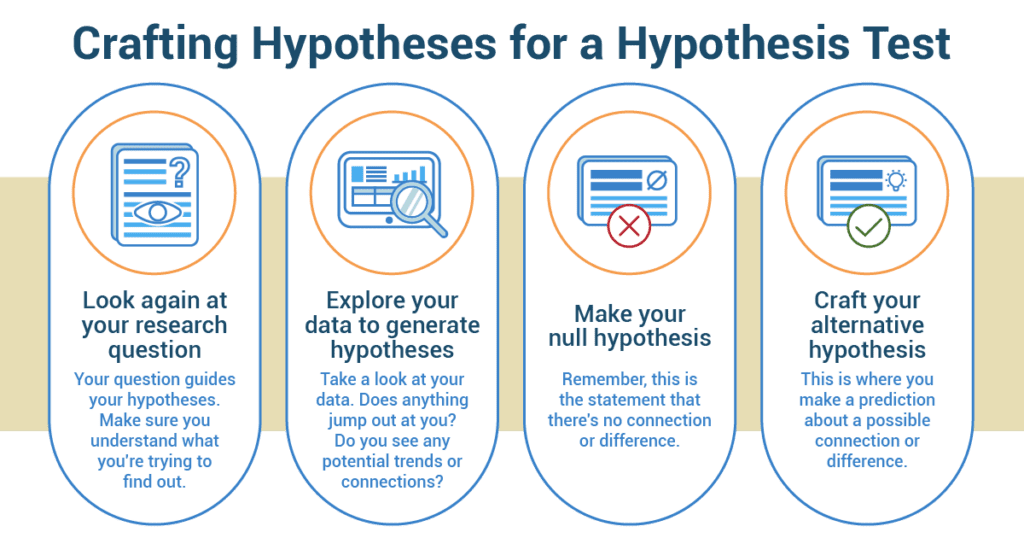Take a moment and imagine this – you’re standing at the crossroads of a busy city street. It’s raining heavily, you’re late for school, and you have two paths to your destination. The path on the left is a straight shot but exposed to the elements ☔, while the path on the right takes you through an underpass, sheltered from the rain but longer.
Now, in the blink of an eye, your brain starts asking questions. “Will the straight path make me wet but get me there faster?” 🤔 “Will the longer path keep me dry but make me even later?” Based on those questions, you make an educated guess or a prediction and choose your path: Taking the path on the right, which includes an underpass, will result in a shorter total travel time. 🚶♀️⏱️ Congratulations, you have crafted a hypothesis!
What Is a Hypothesis, and What Is its Role in a Statistical Study?
It’s essential to remember a hypothesis is different than a research question. A research question is a puzzle you’re trying to solve, like “Does eating more chocolate make people happier?” A hypothesis, on the other hand, is your prediction of the answer, such as, “People who eat more chocolate will report feeling happier.”
We often talk about two types of hypotheses:
- Null hypothesis: The “No difference” statement
The null hypothesis is the grumpy skeptic of the group – it’s the statement that says, “There’s no connection here.” For our chocolate and happiness example, the null hypothesis would be: “Eating more chocolate does not affect people’s happiness.”
- Alternative hypothesis: The “There is a difference” statement
The alternative hypothesis is the hopeful detective in the group. It’s the statement that suggests a difference or connection. In our example, the alternative hypothesis would be: “People who eat more chocolate report feeling happier.”
How Do You Craft Hypotheses for a Hypothesis Test?
You’ve got your detective hat on, and you’re ready to dive into your statistical mystery. But how do you create the perfect hypotheses for your investigation?

What are Helpful Tips for Making Hypotheses?
As you sharpen your detective skills and dive into your statistical investigation, keep these tips in mind:

- Be specific and clear. A good hypothesis isn’t vague – it’s like a road map that guides your research.
- Make sure your hypothesis is testable. Can you test it with the data you have? If not, you might need to rework it.
- Keep an open mind. Don’t get too attached to your first hypothesis. If the data doesn’t support it, be ready to revise.
- Keep your hypothesis simple and focused. Remember, it’s better to fully understand one thing than to partly understand many things.
- If possible, include the direction of the relationship between variables. Is one thing increasing while the other decreases? Or do they both increase together?
- A good hypothesis comes from a well-understood research question. Spend time understanding your question before jumping into hypothesis-making.
- Use your data exploration to find possible hypotheses that answer your research question. Your data is a treasure trove of clues!
- Consider potential alternative explanations for the results you expect to see. Good detectives always consider all possible scenarios.
A Case Study: Henry’s Social Media Hypothesis
 Henry has a passion for understanding the world around him. One day, Henry noticed that his friend Sarah was seemingly unhappy after spending a lot of time on social media. His other friends, too, seemed affected. They would either be too absorbed in their screens or would appear downcast, stressed, or exhausted. Intrigued by this trend, Henry began to wonder, “Is there a link between the time spent on social media and one’s mood?”
Henry has a passion for understanding the world around him. One day, Henry noticed that his friend Sarah was seemingly unhappy after spending a lot of time on social media. His other friends, too, seemed affected. They would either be too absorbed in their screens or would appear downcast, stressed, or exhausted. Intrigued by this trend, Henry began to wonder, “Is there a link between the time spent on social media and one’s mood?”
This observation marked the birth of his first hypothesis: “High school students who spend more time on social media are more likely to feel unhappy.”
With this hypothesis in mind, Henry started an informal survey among his friends and classmates, asking about their daily social media usage and their mood states. It was a simple method, but it gave him a way to test his hypothesis. He carefully noted the responses, ensuring respect for everyone’s privacy and treating the data confidentially.
Henry’s friends soon began to take interest in his project, and a few others who were proficient in data analysis decided to join him. They further refined his initial hypothesis by incorporating measurable elements, thereby leading to a more refined hypothesis: “High school students who spend more than three hours per day on social media are more likely to report feelings of stress, anxiety, or depression.”
Henry’s case study is a prime example of how a simple observation, when paired with curiosity and critical thinking, can lead to the formulation of a hypothesis. And it doesn’t stop there. Hypothesis formulation is just the start; it guides the direction of the investigation and can potentially lead to breakthroughs, whether it’s about social media and mood, rain and travel paths, or the mysteries of the universe!